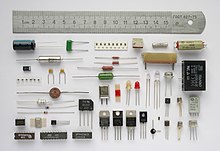Epoxy Molding Compounds (EMC) represent a category of advanced materials utilized in electronic packaging, primarily consisting of epoxy resin, phenolic compounds, curing agent, fillers, and various additives. To safeguard electronic components against mechanical damage, contamination, and moisture, mass production techniques such as injection molding or transfer molding are typically employed to encapsulate these components within the EMC. Upon curing, the epoxy resin develops a three-dimensional network structure that exhibits superior mechanical properties as well as resistance to heat and moisture, rendering it highly effective in protecting devices from environmental factors.
History

The development of semiconductor technology commenced in the 1940s with the introduction of germanium diodes, subsequently progressing with the invention of transistors. This innovation facilitated the miniaturization of circuits and reduced power consumption, thereby catalyzing the emergence of the contemporary computer era. The packaging employed for these semiconductor devices serves to provide protection and enables their connection to printed circuit boards. Initially, the packaging technology utilized for diodes and transistors involved canned sealing. However, with advancements in passivation technology, plastic packaging methods were introduced. This plastic packaging technology has proven instrumental in enabling the mass production and cost-effective supply of semiconductor devices.
The advancement of plastic packaging technology has facilitated its extensive utilization in both consumer and industrial products. Currently, over 80% of semiconductor devices are encapsulated using epoxy molding compounds.
The advancement of semiconductor technology has consistently encountered the challenge of enhancing functionality while simultaneously reducing physical dimensions. The integration of an increasing number of functions onto semiconductor chips has resulted in a corresponding rise in both the number of pins and the overall size of the chips. Conversely, to facilitate more compact arrangements on circuit boards, there has been a trend towards miniaturization and reduction in the thickness of packaging.
Process
Curing
The polymerization of epoxy materials can take place through two primary mechanisms: step-growth polymerization and chain-growth polymerization. In step-growth polymerization, the chemical constituents react incrementally, ultimately yielding a polymer with a high molecular weight. Conversely, chain-growth polymerization involves the successive addition of reactive sites, leading to the formation of a high molecular-weight polymer. Notably, certain curing agents, including dicyandiamide and various anhydrides, facilitate curing through intricate processes that encompass both step growth and catalytic polymerization.
Post-curing
The reactivity of monomers, specifically the quantity of reactive groups present, plays a critical role in influencing their behavior during the gelation process. Monomers characterized by high functionality tend to undergo gelation at a lower level of reaction, yet they possess an increased capacity for cross-linking. To achieve a matrix exhibiting elevated modulus and glass transition temperature, a higher degree of crosslinking is essential, which is a prerequisite for effective post-curing.
Component
Epoxy encapsulation materials are a type of highly filled particulate polymer composite, comprising various components to meet the requirements for reliability, physical properties, and moldability. These components include silica, epoxy resin, hardeners, flame retardants, catalysts, and stress-relaxation additives. The raw materials are mixed at room temperature and subsequently processed in a mixing machine or roller mixer, where they are heated and blended to achieve a homogeneous mixture.
Reference
- Keser, Beth; Kroehnert, Steffen, eds. (2019). "The Role of Liquid Molding Compounds in the Success of Fan-Out Wafer-Level Packaging Technology". Advances in Embedded and Fan-Out Wafer-Level Packaging Technologies. Hoboken, NJ, USA: John Wiley & Sons, Inc. ISBN 978-1-119-31399-1.
- Zhao, Yang; Drummer, Dietmar (2019-11-01). "Influence of Filler Content and Filler Size on the Curing Kinetics of an Epoxy Resin". Polymers. 11 (11): 1797. doi:10.3390/polym11111797. ISSN 2073-4360. PMC 6918384. PMID 31683998.
- ^ Benoit, Henri; Fujita, Hiroshi; Cantow, Hans-Joachim; Dus̆ek, Karel; Henrici-Olivé, Gisela; Heublein, Günter; Höcker, Hartwig; Kausch, Hans-Henning; Kennedy, Joseph Patrick II (1989). "Epoxy Molding Compounds as Encapsulation Materials for Microelectronic Devices". Speciality Polymers/Polymer Physics. Advances in Polymer Science. Berlin, Heidelberg: Springer-Verlag Springer e-books. ISBN 978-3-540-46010-7.
- Johnson, Leah M.; Huffman, Nicolas D. (2016). "Rheology of Epoxy–Thermoplastic Blends". In Parameswaranpillai, Jyotishkumar (ed.). Handbook of Epoxy Blends. Cham: Springer International Publishing. pp. 1–37. doi:10.1007/978-3-319-18158-5_21-1. ISBN 978-3-319-18158-5.
- Jones, Frank R., ed. (2022). "Matrices". Composites Science, Technology, and Engineering. Cambridge: Cambridge University Press. p. 87. doi:10.1017/9781139565943.004. ISBN 978-1-107-03612-3. Archived from the original on 2024-08-20. Retrieved 2024-08-20.
- Tsai, M.-Y.; Wang, C.T.; Hsu, C.H. (September 2006). "The Effect of Epoxy Molding Compound on Thermal/Residual Deformations and Stresses in IC Packages During Manufacturing Process". IEEE Transactions on Components and Packaging Technologies. 29 (3). doi:10.1109/tcapt.2006.880478. ISSN 1521-3331.